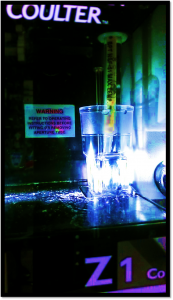Technophile?
Luddite?
Cyborg?
Earlier today I read an article on the computer-controlled cockroaches at NCSU, and I could hear the sci-fi (g)rumblings of the tech-no-philes growing in my head. Equally, the sci-fi promises of technophiles (in the conventionally-spelled manner) also rang out. But practically, what might this brave new world mean, particularly in the context of elementary education?
Cybernetic cockroaches aside, technology in the classroom is maybe a little less brave/new than either side would like to admit. I remember when my (personal) elementary school won an Apple IIe from the grocery store, and getting to use it to program triangular turtles FWD 25. Before that, overheads made think-alouds more transparent (pun sort-of intended), and even earlier, my parents ducked-and-covered to filmstrips intended to bring a touch of movie magic to mandatory matinees (ding). Pencils, pens, mimeographs, textbooks, hornbooks, styluses, tablets (stone or otherwise), each era has had some sort of tool at the ready to disseminate information.
So in some ways, the idea of “new” technology in the classroom is a continuation of what has always been there. Filmstrips begat overheads begat Powerpoint begat Prezi, with mutants, sports, hybrids, and other adaptations along the way. On the other hand, the promise of a truly individualized learning environment never really materialized. Even more, the dark shadows at the edges of this Utopian dream seemed to multiply as rapidly as technologies do today. Are people too dependent? Can we still pay attention? Can we survive? What are the implications for access/restriction of access?
As a teacher in a high-poverty school, I wrestle daily with these shadows. I watch my children, either plugged in and downloading or staring jealously from the side. What strikes me, though, in both cases, is how my students think about technology. They see it as unlimited infotainment, tidbits of interesting available for their consumption. It is everyday magic and unquestioned.
This, to me, is the most interesting challenge I face in leveraging technology, and one that extends beyond the question of accessing the Internet to watch a flipped video. To me, this challenge is about the very stuff of education: teaching for freedom. In his book, Radical Equations, Bob Moses frames education as a civil right in that it makes individuals and communities more free. In our post-modern age, I believe that teaching for freedom includes enabling students to reclaim the old meaning of technology, to re-define technology as a tool that they can control, manipulate, and re-mix in their own quests for freedom.
I have posted before about the Maker Movement, and I still feel that the Maker spirit is one way to reclaim technology. For example, at Maker Faire NC this year, tatters, 3D printers, and a trebuchet shared the same venue. Though the technologies showcased differed in electronic components and associated time periods, all displays showcased people learning, sharing, and pushing the boundaries of the tools available to them in order to realize their personal dreams, to become more free in the existential sense. This is the technology I strive for in the classroom.
Cockroaches optional.

